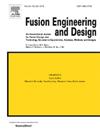利用瞬态光栅光谱学、TEM 和原子模拟阐明 W-Ta 合金的热响应
IF 1.9
3区 工程技术
Q1 NUCLEAR SCIENCE & TECHNOLOGY
引用次数: 0
摘要
钨合金作为面向等离子体的组件材料,其热反应及其在辐照下的演化至关重要。本研究利用瞬态光栅光谱学、TEM 和分子动力学,试图探究 W、W6Ta 和 W11Ta 合金的这些变化。使用 12.25 MeV W6+ 离子在麻省理工学院的 CLASS 设备中进行辐照,温度为 500 °C,剂量为 0.1、0.3 和 1.0 dpa。结果发现,合金的热扩散率的衰减程度低于纯合金。分子动力学模拟显示,这是由于低于 TEM 分辨率的缺陷群减少所致。尽管这些合金显示出更强的抗热性能退化能力,但研究发现它们的热扩散率绝对值仍然低于纯钨。这项研究强调了合金添加物增强辐射耐受性与合金添加物最初对热反应的负面影响之间的关键相互作用,因此也强调了使用中的行为。本文章由计算机程序翻译,如有差异,请以英文原文为准。
Elucidating the thermal response of W-Ta alloys with Transient Grating Spectroscopy, TEM and atomistic simulation
Critical for tungsten alloys’ use as plasma-facing component materials are their thermal response and their evolution under irradiation. Utilising Transient Grating Spectroscopy, TEM, and Molecular Dynamics, this study sought to probe these changes in W, W6Ta, and W11Ta alloys. Irradiation with 12.25 MeV W ions was carried out in the CLASS facility at MIT at a temperature of 500 °C for doses of 0.1, 0.3, and 1.0 dpa. The alloys’ thermal diffusivity was found to degrade less than that of the pure counterpart. Molecular Dynamics simulation revealed that this was due to a reduced defect population below TEM resolution. Despite these alloys showing enhanced resilience to thermal property degradation, it was found that the absolute values of their thermal diffusivity remained below that of pure tungsten. This study highlighted a key interplay between enhancing radiation tolerance with alloying additions and the alloy additions’ initial negative effect on the thermal response and thus in-service behaviour.
求助全文
通过发布文献求助,成功后即可免费获取论文全文。
去求助
来源期刊

Fusion Engineering and Design
工程技术-核科学技术
CiteScore
3.50
自引率
23.50%
发文量
275
审稿时长
3.8 months
期刊介绍:
The journal accepts papers about experiments (both plasma and technology), theory, models, methods, and designs in areas relating to technology, engineering, and applied science aspects of magnetic and inertial fusion energy. Specific areas of interest include: MFE and IFE design studies for experiments and reactors; fusion nuclear technologies and materials, including blankets and shields; analysis of reactor plasmas; plasma heating, fuelling, and vacuum systems; drivers, targets, and special technologies for IFE, controls and diagnostics; fuel cycle analysis and tritium reprocessing and handling; operations and remote maintenance of reactors; safety, decommissioning, and waste management; economic and environmental analysis of components and systems.
 求助内容:
求助内容: 应助结果提醒方式:
应助结果提醒方式:


